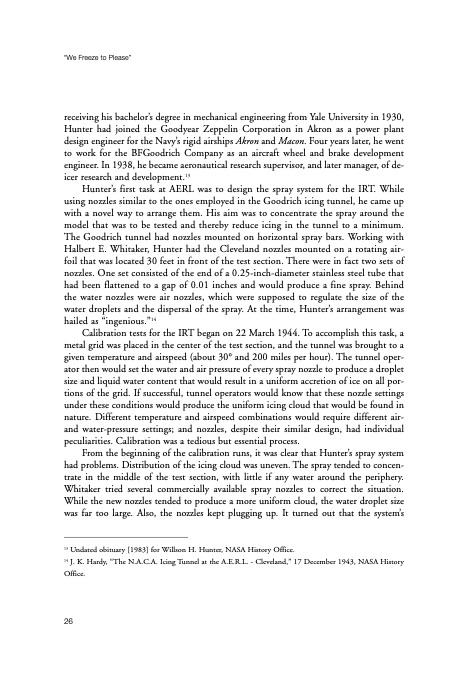
PDF Publication Title:
Text from PDF Page: 039
“We Freeze to Please” receiving his bachelor’s degree in mechanical engineering from Yale University in 1930, Hunter had joined the Goodyear Zeppelin Corporation in Akron as a power plant design engineer for the Navy’s rigid airships Akron and Macon. Four years later, he went to work for the BFGoodrich Company as an aircraft wheel and brake development engineer. In 1938, he became aeronautical research supervisor, and later manager, of de- icer research and development.13 Hunter’s first task at AERL was to design the spray system for the IRT. While using nozzles similar to the ones employed in the Goodrich icing tunnel, he came up with a novel way to arrange them. His aim was to concentrate the spray around the model that was to be tested and thereby reduce icing in the tunnel to a minimum. The Goodrich tunnel had nozzles mounted on horizontal spray bars. Working with Halbert E. Whitaker, Hunter had the Cleveland nozzles mounted on a rotating air- foil that was located 30 feet in front of the test section. There were in fact two sets of nozzles. One set consisted of the end of a 0.25-inch-diameter stainless steel tube that had been flattened to a gap of 0.01 inches and would produce a fine spray. Behind the water nozzles were air nozzles, which were supposed to regulate the size of the water droplets and the dispersal of the spray. At the time, Hunter’s arrangement was hailed as “ingenious.”14 Calibration tests for the IRT began on 22 March 1944. To accomplish this task, a metal grid was placed in the center of the test section, and the tunnel was brought to a given temperature and airspeed (about 30° and 200 miles per hour). The tunnel oper- ator then would set the water and air pressure of every spray nozzle to produce a droplet size and liquid water content that would result in a uniform accretion of ice on all por- tions of the grid. If successful, tunnel operators would know that these nozzle settings under these conditions would produce the uniform icing cloud that would be found in nature. Different temperature and airspeed combinations would require different air- and water-pressure settings; and nozzles, despite their similar design, had individual peculiarities. Calibration was a tedious but essential process. From the beginning of the calibration runs, it was clear that Hunter’s spray system had problems. Distribution of the icing cloud was uneven. The spray tended to concen- trate in the middle of the test section, with little if any water around the periphery. Whitaker tried several commercially available spray nozzles to correct the situation. While the new nozzles tended to produce a more uniform cloud, the water droplet size was far too large. Also, the nozzles kept plugging up. It turned out that the system’s 13 Undated obituary [1983] for Willson H. Hunter, NASA History Office. 14 J. K. Hardy, “The N.A.C.A. Icing Tunnel at the A.E.R.L. - Cleveland,” 17 December 1943, NASA History Office. 26PDF Image | History of NASA Icing Research Tunnel

PDF Search Title:
History of NASA Icing Research TunnelOriginal File Name Searched:
sp4226.pdfDIY PDF Search: Google It | Yahoo | Bing
NFT (Non Fungible Token): Buy our tech, design, development or system NFT and become part of our tech NFT network... More Info
IT XR Project Redstone NFT Available for Sale: NFT for high tech turbine design with one part 3D printed counter-rotating energy turbine. Be part of the future with this NFT. Can be bought and sold but only one design NFT exists. Royalties go to the developer (Infinity) to keep enhancing design and applications... More Info
Infinity Turbine IT XR Project Redstone Design: NFT for sale... NFT for high tech turbine design with one part 3D printed counter-rotating energy turbine. Includes all rights to this turbine design, including license for Fluid Handling Block I and II for the turbine assembly and housing. The NFT includes the blueprints (cad/cam), revenue streams, and all future development of the IT XR Project Redstone... More Info
Infinity Turbine ROT Radial Outflow Turbine 24 Design and Worldwide Rights: NFT for sale... NFT for the ROT 24 energy turbine. Be part of the future with this NFT. This design can be bought and sold but only one design NFT exists. You may manufacture the unit, or get the revenues from its sale from Infinity Turbine. Royalties go to the developer (Infinity) to keep enhancing design and applications... More Info
Infinity Supercritical CO2 10 Liter Extractor Design and Worldwide Rights: The Infinity Supercritical 10L CO2 extractor is for botanical oil extraction, which is rich in terpenes and can produce shelf ready full spectrum oil. With over 5 years of development, this industry leader mature extractor machine has been sold since 2015 and is part of many profitable businesses. The process can also be used for electrowinning, e-waste recycling, and lithium battery recycling, gold mining electronic wastes, precious metals. CO2 can also be used in a reverse fuel cell with nafion to make a gas-to-liquids fuel, such as methanol, ethanol and butanol or ethylene. Supercritical CO2 has also been used for treating nafion to make it more effective catalyst. This NFT is for the purchase of worldwide rights which includes the design. More Info
NFT (Non Fungible Token): Buy our tech, design, development or system NFT and become part of our tech NFT network... More Info
Infinity Turbine Products: Special for this month, any plans are $10,000 for complete Cad/Cam blueprints. License is for one build. Try before you buy a production license. May pay by Bitcoin or other Crypto. Products Page... More Info
| CONTACT TEL: 608-238-6001 Email: greg@infinityturbine.com | RSS | AMP |